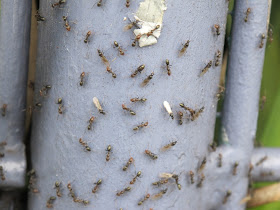I was up at the sanctuary today, and we came across some ants swarming. One of the other people didn't know much about the process, so I pulled this out of the old files: it follows on from the previous entry in this blog.
There are two lay reactions to "flying ants". Some
people think them as real as flying monkeys or drop bears, while a larger group
will assure you that they exist, and tell you they are termites on the move. In
fact, they are proper ants, Formicidae, but not the usual ground-runners.
Flying ants are the sexually mature forms that the ants
(and Australia alone has some 3000 species of ants) use to establish new colonies. The
confusion with termites is understandable, because "white ants" also
use a similar dispersal method.
Termites, though, are more closely related to the
cockroaches, while the ants are near relatives of wasps. Ants and termites are
both important recyclers, but I will stay with the ants here. The termites can
wait.
Old bush wisdom says ants swarm and send off their
colonists on days when it is warm and humid, though some scientists think
suitable air currents need to be available. Humidity and warmth seem to be the
main factors.
 |
| Early stages of the swarm: males (wings) and workers. |
It helps them if many nests swarm at the same time: it
gives the ants a better chance of slipping past the birds and bats seeking a
tasty snack. There is also a better chance of cross-breeding between nests, so
it's a win-win.
You will usually see the males first, because there are more
of them, and a smaller number of "queens" or fertile females. The
males, as you can see above, are roughly the same size as the non-fertile
female workers.
The queens, on the other hand, are much larger, because they
will need to lay enough eggs to raise the first crop of workers for the new
nest.
 |
| A queen, males and workers. The larger pipe is a 45 mm diameter, so the workers are about 12 mm long |
The workers do a lot of formicating (this is the technical
term for "rushing around like ants" and a great word for mentioning in sedate
tea parties). People say the workers are grooming the queen, but nobody seems
to quite know what this achieves,
When they fly off, the males and females mate on the wing, the males die soon after and the queens land, find or make a shelter, and start laying eggs, if they are lucky.
 |
| Queen with some worker ants. |
Flying ants may be alarming, but without flying ants, there would be no ants. Without ants, your garden would stink from all the dead animals.
Learn to like flying ants!
No comments:
Post a Comment